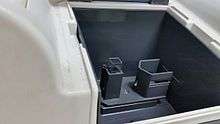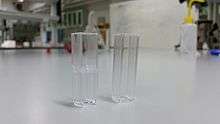Cuvette




A cuvette (from French cuvette = "little vessel") is a small tube of circular or square cross section, sealed at one end, made of plastic, glass, or fused quartz (for UV light) and designed to hold samples for spectroscopic experiments. Disposable plastic cuvettes are often used in fast spectroscopic assays, where speed is more important than high accuracy. Glass cuvettes are typically for use in the wavelength range of visible light and fused quartz tends to be used in the UV through NIR ranges.
The other types of cuvettes are more expensive than the plastic cuvette. It is disposable and will be eliminated once complete the spectrometric experiment to prevent risk from reusing cuvettes and damaging expensive quartz. Color and UV range can be analyzed by this type of cuvette. The smallest one are capable of holding 70µl, the medium size contains between 1.5ml and 3.0ml, and the biggest is for testing samples with 2.5ml or larger.[1]
Some cuvettes will be clear only on opposite sides, so that they pass a single beam of light through that pair of sides; often the unclear sides have ridges or are rough to allow easy handling. Cuvettes to be used in fluorescence spectroscopy[2] must be clear on all four sides because fluorescence is measured at a right-angle to the beam path to limit contributions from beam itself. Some cuvettes, known as tandem cuvettes, have a glass barrier that extends 2/3 up inside, so that measurements can be taken with two solutions separated, and again when they are mixed. Typically, cuvettes are 10 mm (0.39 in) across, to allow for easy calculations of coefficients of absorption. To measure the sample, the transparent side must be placed toward the light in spectrophotometer. For accurate measurement, these testing tubes should be cleaned and without any scratches.[3]
Cuvettes to be used in circular dichroism[4] experiments should never be mechanically stressed, as the stress will induce birefringence[5] in the quartz and affect the measurements made.
There are several different types of cuvettes commonly used; each type has different usable wavelengths at which its transparency exceeds 80%:
- Optical Glass, has an optical wavelength range of 340-2,500nm in which it transmits over 80% along with a matching tolerance of 1% at 350nm.
- Plastic, with a wavelength from 380 to 780 nm (visible spectrum).
- Fused quartz, with a wavelength below 380 nm (ultraviolet spectrum).
- UV quartz has an operational wavelength range of 190-2,500 nm, and a matching tolerance of 1% at 220 nm.[6]
 Sizes of 1mL & 3mL cuvettes
Sizes of 1mL & 3mL cuvettes - ES quartz has a usable wavelength range of 190 to 2,000 nm, and a matching tolerance of 1% at 220 nm.
- IR quartz has a usable wavelength range of 220 to 3,500 nm, and a matching tolerance of 1% at 2,730 nm.
| Wikimedia Commons has media related to Cuvettes. |
References
- ↑ "Plastic Cuvettes / Disposable Cuvettes | Biocompare.com". www.biocompare.com. Retrieved 2016-03-17.
- ↑ An Introduction to Fluorescence Spectroscopy Perkin Elmer Inc. 2006. Retrieved 15 August 2013
- ↑ "Cuvette". chemed.chem.purdue.edu. Retrieved 2016-03-17.
- ↑ Circular Dichroism (CD) Spectroscopy Applied Photophysics Ltd., 2011. Retrieved 15 August 2013
- ↑ Weisstein, Eric, W. "Birefringence" scienceworld.wolfram.com, Wolfram Research, 1996-2007. Retrieved 15 August 2013
- ↑ Glossary of Common Spectroscopy Terms fireflysci.com. Retrieved 10 June 2015